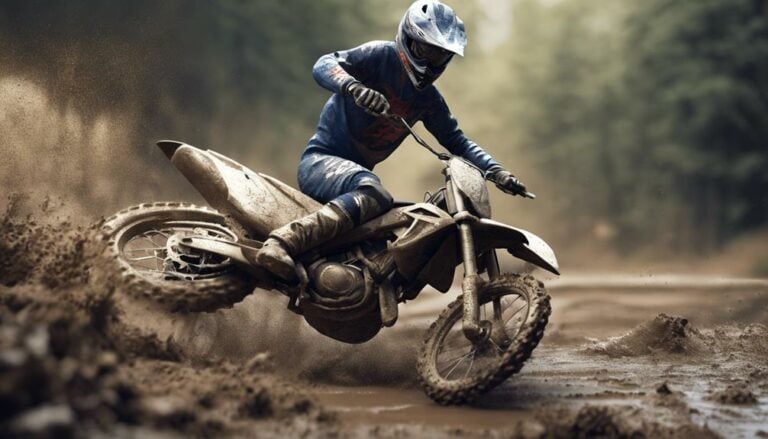When tackling muddy or slippery paths on your dirt bike, understanding the art of braking is paramount.
You may wonder if there are specific techniques to enhance your control in such challenging conditions.
By mastering the right braking methods, you can navigate treacherous terrains with confidence.
Stay tuned to discover the nuanced strategies that can help you maneuver safely through the muck and maintain your balance on slippery slopes.
Key Takeaways
- Prioritize rear brake for traction in muddy or slippery conditions.
- Apply gradual brake pressure to avoid skidding and maintain control.
- Utilize engine braking and downshifting for smooth deceleration assistance.
- Adapt braking technique with 80/20 balance for stability in challenging terrains.
Importance of Proper Braking in Mud
Proper braking technique is paramount when riding a dirt bike in muddy conditions to guarantee control and prevent accidents. In such challenging terrain, understanding the dynamics of using the front wheel and rear brake is vital.
When moving through mud, relying more on the rear brake than the front brake can help prevent skidding and maintain traction. By applying the brakes gently and gradually, you can avoid locking up the wheels and sliding in slippery conditions. Implementing the 80/20 technique, where 80% of the braking power comes from the rear brake and 20% from the front brake, enhances stability and control.
Anticipate the reduced stopping power in muddy conditions by braking earlier and allowing for more distance to safely come to a stop. Mastering the balance between the front wheel and rear brake is key to maneuvering through mud with confidence and skill.
Understanding Braking Dynamics in Slippery Conditions
When riding your dirt bike in slippery conditions, mastering the art of braking dynamics is important for maintaining control and avoiding accidents. In slippery terrains, the way you apply your brakes can make a significant difference in how well you handle your bike. Understanding braking dynamics involves knowing how to distribute the braking force between the front and rear brakes to prevent skidding and maintain stability. Here are some key points to take into account:
| Braking Dynamics Tips |
|---|
| Use more rear brake than front brake |
| Apply brakes smoothly and gradually |
| Maintain a light touch on the front brake to prevent washouts |
| Utilize engine braking and downshifting |
| Practice controlled braking techniques in various slippery conditions |
Essential Braking Techniques for Muddy Terrain
In traversing muddy terrain on your dirt bike, prioritize utilizing the rear brake over the front brake to maintain traction and prevent sliding. Adjust your tire pressure to suit the conditions, providing better grip.
When braking in muddy terrain, remember that the front end is more prone to washing out, so relying more on the rear brake can help keep your bike stable. Apply gradual and consistent pressure on the brakes to avoid locking up and skidding.
Additionally, make use of engine braking by downshifting smoothly to assist in deceleration without solely depending on the brakes. Avoid sudden or aggressive braking inputs as they can lead to loss of control on the slippery surface.
Practice modulating your brakes to find the right balance between slowing down and maintaining stability in challenging muddy conditions. By mastering these essential braking techniques, you can confidently navigate muddy terrain with control and finesse.
Tips for Effective Braking on a Dirt Bike
For more effective braking on your dirt bike, prioritize utilizing the rear brake to maintain traction and control in various riding conditions. When riding in muddy terrain, it's important to adapt your braking technique to the slippery surface. To brake hard in these conditions, rely more on the rear brake to prevent skidding and maintain stability. Apply gradual pressure on the brakes to avoid locking up the wheels, allowing for smoother deceleration. Additionally, make use of engine braking by downshifting to help slow down the bike smoothly, especially when traversing through challenging mud-covered paths.
Avoid sudden or aggressive braking maneuvers, as these can lead to loss of control and traction on the slippery surface. Instead, practice controlled braking techniques to enhance your skills and build confidence in varying muddy or slippery conditions. By mastering effective braking methods, you can improve your overall riding experience and stay safe while conquering challenging terrains.
Common Mistakes to Avoid When Braking in Mud
To enhance your braking performance in muddy conditions, steer clear of common mistakes that can compromise your control and safety on the slippery terrain. Remember, in mud, every move counts. Here are some common mistakes to avoid when braking in mud:
- Avoid Locking Up the Brakes:
Prevent skidding and loss of control by not locking up the brakes. Maintain traction by applying gradual pressure on both front and rear brakes.
- Utilize the 80/20 Braking Technique:
Focus 80% on the rear brake and 20% on the front brake. This distribution enhances control and stability in muddy conditions.
- Keep Your Body Position Low and Centered:
Maintain balance by lowering your center of gravity. This helps prevent the bike from sliding out during braking.
- Look Ahead:
Always scan the terrain ahead to anticipate obstacles and plan your braking strategy accordingly. Keeping your eyes forward improves reaction time and overall control.
Conclusion
To sum up, mastering proper braking techniques in muddy or slippery conditions on a dirt bike is essential for maintaining control and preventing accidents.
By focusing on using the rear brake more than the front brake, utilizing the 80/20 braking technique, and anticipating obstacles while keeping your head up and eyes forward, you can navigate challenging terrain safely and confidently.
Remember, practice makes perfect, so keep honing your skills to become a skilled rider in any conditions.

